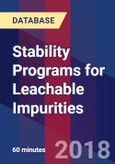Why Should You Attend:
Leachables are impurities which originate from contact surfaces (typically the final container/closure) of the drug product. As with drug product related impurities it is important to monitor the leachables over the shelf-life of the products to ensure patient safety. Performing leachable stability studies can be challenging and is generally less understood than for typical drug product related impurities. There are several key differences between leachables and drug product related impurities which must be understood in order to design an effective stability program.
This presentation will cover: what are leachables, where they come from, what are the similarities and differences in comparison with drug product related impurities and what are the method and stability requirements.
Areas Covered in the Webinar:
Background and Overview of Leachables
What are extractables and leachables
Where do they come from
Why is there concern
How to Design and Implement Leachable Stability Programs
What are the requirements for leachable stability programs
How to develop and validate methods for use in leachable stability programs
Drug product impurities vs. leachable impurities
Common pitfalls associated with leachable stability programs
Leachables are impurities which originate from contact surfaces (typically the final container/closure) of the drug product. As with drug product related impurities it is important to monitor the leachables over the shelf-life of the products to ensure patient safety. Performing leachable stability studies can be challenging and is generally less understood than for typical drug product related impurities. There are several key differences between leachables and drug product related impurities which must be understood in order to design an effective stability program.
This presentation will cover: what are leachables, where they come from, what are the similarities and differences in comparison with drug product related impurities and what are the method and stability requirements.
Areas Covered in the Webinar:
Background and Overview of Leachables
What are extractables and leachables
Where do they come from
Why is there concern
How to Design and Implement Leachable Stability Programs
What are the requirements for leachable stability programs
How to develop and validate methods for use in leachable stability programs
Drug product impurities vs. leachable impurities
Common pitfalls associated with leachable stability programs
Speakers
Dr. Wayland Rushing is a technical expert in chemistry, manufacturing and controls (CMC) program design, analytical development and regulatory submissions. Over his 15-year career, he has led CMC development programs for a wide array of biopharmaceuticals, including parenterals, inhalation drugs, and other pharmaceuticals with complex delivery systems.Dr. Rushing is a subject matter expert in HPLC and GC method development and validation, extractables and leachables program design and regulatory submission requirements; has drafted multiple IND and NDA submissions; and assists ABC clients in responding to FDA deficiency letters. He currently serves on Parenteral Drug Association (PDA) advisory committees for Technology Transfer and Elastomeric Closures and Seals Presentation Summary and was co-author of PDA TR 65, Technology Transfer.








